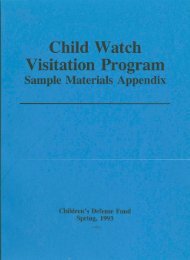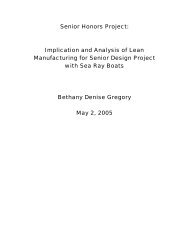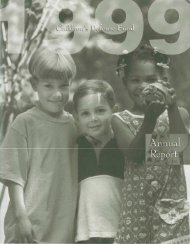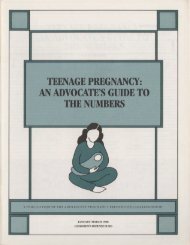child care - Digital Library Collections
child care - Digital Library Collections
child care - Digital Library Collections
You also want an ePaper? Increase the reach of your titles
YUMPU automatically turns print PDFs into web optimized ePapers that Google loves.
SPOTLIGHT ON HOUSING AND HOMELESSNESS<br />
The severe ton on <strong>child</strong>ren. Lack ofadequate, affordable housing has adverse consequences<br />
for all poor Americans, but the impact is particularly harsh on <strong>child</strong>ren. Inability to afford<br />
housing is one reason poor families tend to move from place to place, forcing the <strong>child</strong>ren to<br />
change schools frequently. A new CDP report, Poverty Matters, cites studies showing that these<br />
<strong>child</strong>ren have lower math and reading scores and are much less likely to fmish high school on<br />
time. Poverty Matters also reports findings that poor <strong>child</strong>ren often live in poor housing with<br />
faulty pipes and other water leakage problems, which can result in mold and roach infestations.<br />
These, in tum, cause many <strong>child</strong>ren to develop respiratory diseases like asthma, which are<br />
major reasons for missing school. Poor <strong>child</strong>ren also have more than triple the average risk of<br />
lead poisoning because of exposure to lead paint, a common problem in old housing. Lead<br />
poisoning causes neurological damage and has been linked to lower IQ and long-term behavioral<br />
problems.<br />
The Doc4Kids Project at Boston Medical Center and Children's Hospital has compiled<br />
numerous examples of <strong>child</strong>ren whose health has been compromised by poor housing. The<br />
1998 project report, Not Safe at Home: How AmericasHousing Crisis Threatens the Health ofIts<br />
Children, documents cases of toddlers who develop life-threatening asthma because of cockroaches<br />
in summer or inadequate heat in winter and school<strong>child</strong>ren whose brains have been<br />
poisoned by lead. Such health damage can permanently cloud <strong>child</strong>ren's futures, increasing<br />
medical costs and impairing their ability to learn and work.<br />
The impact on young families. Paying for housing is a particular strain for the 5.8 million<br />
families headed by a parent under the age of 30, who tend to have low earning power and high<br />
<strong>child</strong> <strong>care</strong> expenses. A 1997 CDP report, Rescuing the American Dream, noted that in 1993 more<br />
than 2 million (38 percent) ofthese young families exceeded federal affordability standards by<br />
spending more the 30 percent of their income on housing. A substantial number-900,OOospent<br />
more than 50 percent.<br />
Those who aspire to homeownership are fmding it harder and harder to attain. Rescuing the<br />
American Dream found that in March 1980 nearly one young family in two owned their own<br />
home; by March 1994 that proportion had dropped to only one in three. In the past, many<br />
young parents earned enough income to save up for a down payment or were helped on the path<br />
to homeownership by programs like the GI Bill. Today, With wages falling for young workers<br />
(see chapter 1), too many struggle simply to pay the rent.<br />
Roughly 1.6 million young families cope with high housing costs by "doubling up" with<br />
grandparents or other relatives. Some have little choice; doubling up is sometimes the last step<br />
before landing in a homeless shelter. The crowded housing conditions that may arise when<br />
families try to share expenses can contribute to increases in respiratory infections, family<br />
conflicts, and other stresses.<br />
Dwindling housing supply and more homelessness. A key finding of the Joint Center for<br />
Housing Studies 1997 report is that the recent revisions in welfare programs will lead to further<br />
erosion of the nation's stock ofaffordable rental housing. The new welfare rules will lower the<br />
incomes, and therefore the rent-paying ability, ofthe poorest people. Private landlords, in tum,<br />
reaping less revenue, will have fewer resources and less incentive to maintain low,;ost rental<br />
CHILDREN'S DEFENSE FUND 17














